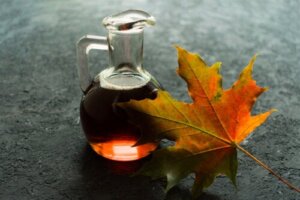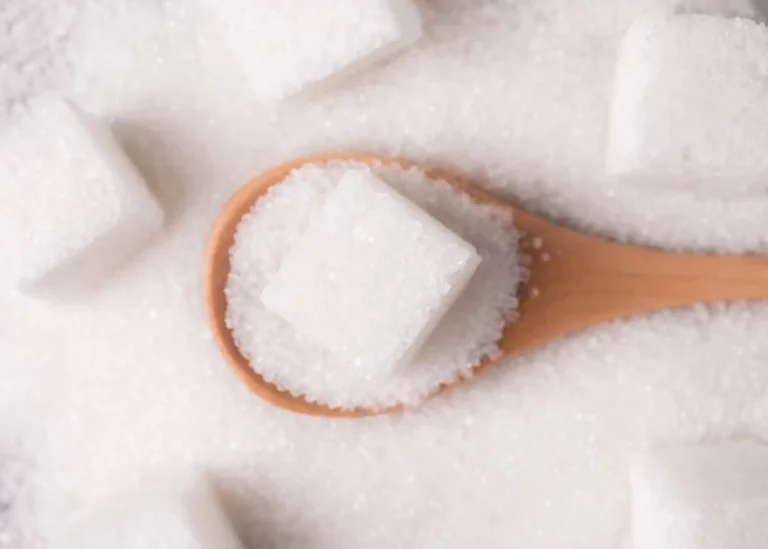Maple Syrup: Properties and Uses in the Kitchen


Written and verified by the nutritionist Saúl Sánchez Arias
Maple syrup is a natural sweetener used as a substitute for table sugar, coming from the sap of a tree of the same name. It’s a vegetable native to North America, although Canada is currently the largest producer worldwide.
This sweetener can be found in almost any supermarket and offers a number of health benefits, especially compared to other types of sweeteners.
Before we begin, it’s important to note that the presence of sweetness in the diet should be reduced in order for the body to function optimally. Most diets, nowadays, have a dominance of this organoleptic characteristic, which can be harmful in the medium term. The presence of sweetness in the mouth could trigger insulin production, which would generate pancreatic stress.
What is maple syrup?
Maple syrup is a golden, viscous, sweet and aromatic product used to sweeten culinary preparations. It could be compared to honey or other vegetable syrups, such as fruit syrups. It’s normally used in confectionery or pastry recipes, although it can also be added to beverages, toast, and dairy products.
Its preparation is quite simple. The first thing to do is to obtain the sap from the wood of maple trees. To do this, a cut is made on the bark of the trunk and a bucket is placed just below.
After a while, it will be filled with a thick syrup. The syrup is then filtered and sorted according to flavor and color before bottling. Certain reverse osmosis processes can even be put in place to remove the excess water.
It’s important to note that there are several types of maple syrup. Grade A syrups are the highest quality, and hardly have any imperfections. The color is uniform and the flavor is very pure. In general, they provide very intense organoleptic characteristics.
Then there are grade 0 syrups, and, in this case, there may be impurities or a somewhat cloudy color; the quality is inferior.
Finally, there are those known as Substandard. These are more like a sweet syrup as such, without the flavor and aroma notes typical of maple syrup. It’s the lowest quality product that may have undergone an intense refining process.

Find out more: Make Your Own Sweetener: How to Grow Stevia at Home
Maple syrup: nutritional properties
Maple syrup is composed primarily of sucrose and water. For this reason, it has a significant impact on blood glucose levels. This is something to be careful about, as regular consumption of simple sugars has been shown to increase the risk of developing metabolic pathologies, such as type 2 diabetes. This is evidenced by research published in the journal Current Diabetes Reports.
For every 100 grams (4 oz) of the product, maple syrup provides about 265 kcal, 67% of which comes from simple carbohydrates. It’s true that white sugar has a higher glycemic index, but, for practical purposes, the impact of both foods on the body is quite similar. Neither should be abused to ensure the proper functioning of the metabolism in the medium term.
However, maple syrup contains phytochemicals with antioxidant capacity. These elements neutralize the formation of free radicals and their subsequent accumulation in the body’s tissues, as stated in a study published in the journal Infectious Disorders Drug Targets. However, this won’t be enough to compensate for the effect of free sugars.
Pay attention to the quality of maple syrup when buying it.
How to use maple syrup in cooking?
Maple syrup is a product that can improve the final result of many sweet preparations. It’s included in recipes as a substitute for other sweeteners to provide very characteristic flavors.
Although it’s possible to serve it raw as a dressing, it can also be used in different dishes that will undergo cooking processes. It can even be used in baked items.
However, it must be taken into account that it has a greater sweetening capacity than sugar. Therefore, the amount used in recipes should be corrected if it’s used as a substitute for other sweeteners. Normally, a total of 3/4 cup of maple syrup should be added for each cup of sugar.
When storing this product, ensure that it’s kept in a cool, dry place away from sunlight. It can have a long shelf life, even more than 2 years. However, when it’s opened, it’s best to keep it refrigerated, in the refrigerator door. Under these conditions, it will keep for a year without a problem.

You may also be interested in: The Sugar Busters Diet: What Is It?
Maple syrup, a very tasty sweetener
As you have seen, maple syrup is a sweetener with a characteristic flavor that can be excellent for improving the final result of different desserts.
It’s often used mixed with butter, added to cereals, as toppings, and even as part of glazes for savory dishes, such as roast meat. Its shelf life is long and there are different types of qualities available on the market.
Finally, remember to be moderate with the presence of sweet items in your diet. They tend to have an impact on blood sugar levels, generating an overdemand on the pancreas.
It’s true that if you exercise regularly, the dangers are less, but you should still limit the consumption of this type of food. Above all, it’s necessary to look at the labeling in case they’re of industrial origin, in order to rule out the presence of trans fats.
All cited sources were thoroughly reviewed by our team to ensure their quality, reliability, currency, and validity. The bibliography of this article was considered reliable and of academic or scientific accuracy.
- Yoshida, Y., & Simoes, E. J. (2018). Sugar-Sweetened Beverage, Obesity, and Type 2 Diabetes in Children and Adolescents: Policies, Taxation, and Programs. Current diabetes reports, 18(6), 31. https://doi.org/10.1007/s11892-018-1004-6
- Alkadi H. (2020). A Review on Free Radicals and Antioxidants. Infectious disorders drug targets, 20(1), 16–26. https://doi.org/10.2174/1871526518666180628124323
This text is provided for informational purposes only and does not replace consultation with a professional. If in doubt, consult your specialist.








